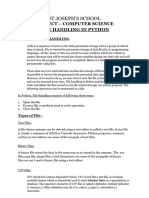Python File Handling Functions
Uploaded by
hs285544Python File Handling Functions
Uploaded by
hs285544Department of Computer Science & Engineering
FILE HANDLING IN PYTHON
SESSION 2023-2024
SUBMITTED BY: SUBMITTED TO:
HIMANSHU SAINI MR. MEGH SINGHAL
2201920100143 ASSISTANT PROFESSOR
CSE 2nd YEAR CSE DEPARTMENT
FILE HANDLING
File handling in python allows the user to read, write, and other operation on
file. Python treats files directly as text or binary. Each line of code includes a
sequence of characters and they form a text file.
File Handling Functions
1. open()
2. write()
3. close()
4. delete()
Department of Computer Science & Engineering
MODES OF FILE OPENING
“r” - (Read) Open a file for reading, error if the file does not exist
“a”- (Append) Opens a file for appending, creates the file if it does not
exist
“w” -(Write) Opens a file for writing, creates the file if it does not exist
“x” -(Create) It create a new file, error occurs if file already exists.
Syntax
f = open(filename, mode)
Department of Computer Science & Engineering
FILE OPENING IN READ MODE
Code
print("Himanshu Saini\n2201920100143")
f = open("Himanshu.txt", "r")
print(f.read())
Output
Department of Computer Science & Engineering
FILE OPENING IN WRITE MODE
Code
print("Himanshu Saini\n2201920100143")
f= open("Himanshu.txt","w")
f.write("Now the file has more content!")
f.close()
p= open("Himanshu.txt","r")
print(p.read())
Output
Department of Computer Science & Engineering
FILE OPENING IN APPEND MODE
Code
print("Himanshu Saini\n2201920100143")
f = open("Himanshu.txt", "a")
f.write("Now the file has more content!")
f.close()
p = open("Himanshu.txt", "r")
print(p.read())
Output
Department of Computer Science & Engineering
FILE CLOSING IN PYTHON
close() function closes the file. It is used at the time when the file is
no longer needed or if it is to be opened in a different file mode.
Syntax
file_object.close()
Code
file1 = open("Himanshu.txt", "r")
file1.close()
Department of Computer Science & Engineering
FILE DELETION IN PYTHON
To delete a file, we will have to import the OS module and run its
os.remove() function
Syntax
os.remove(“filename”)
Code
import os
if os.path.exists("Himanshu.txt"):
os.remove("Himanshu.txt")
else:
print("The file does not exist")
Department of Computer Science & Engineering
Thank You
Department of Computer Science & Engineering
You might also like
- Status of Standards 2013-09-05 FEPApublicNo ratings yetStatus of Standards 2013-09-05 FEPApublic1 page
- Transformational Leadership in Health Care Today: Beverly Robbins, RN, BSN Ruth Davidhizar, RN, DNS, ARNP, BC, FAANNo ratings yetTransformational Leadership in Health Care Today: Beverly Robbins, RN, BSN Ruth Davidhizar, RN, DNS, ARNP, BC, FAAN5 pages
- CLASS XII COMPUTER SCIENCE NOTES Chapter 2 File Handling in PythonNo ratings yetCLASS XII COMPUTER SCIENCE NOTES Chapter 2 File Handling in Python4 pages
- Neeraj Kumar (2201920100191) Python PptNo ratings yetNeeraj Kumar (2201920100191) Python Ppt12 pages
- File Handling in Python Last Updated 25-04-2024 240426 180346No ratings yetFile Handling in Python Last Updated 25-04-2024 240426 18034634 pages
- Creating and Manipulating Files: File HandlingNo ratings yetCreating and Manipulating Files: File Handling31 pages
- Unit5 FileHandlingpdf 2023 10 17 09 15 48No ratings yetUnit5 FileHandlingpdf 2023 10 17 09 15 4828 pages
- Python Prog Unit-4 Notes by Kamal Kant TripathiNo ratings yetPython Prog Unit-4 Notes by Kamal Kant Tripathi19 pages
- Class Xii Computer Science Ch-6file HandlingpptNo ratings yetClass Xii Computer Science Ch-6file Handlingppt62 pages
- File Handling (Text, Binary, CSV) CLASS XII COMPUTER SCIENCENo ratings yetFile Handling (Text, Binary, CSV) CLASS XII COMPUTER SCIENCE56 pages
- A High-Level, Interpreted and General-Purpose Dynamic Programming Language That Focuses On Code ReadabilityNo ratings yetA High-Level, Interpreted and General-Purpose Dynamic Programming Language That Focuses On Code Readability15 pages
- Python File Handling Made Easy: A Practical Guide with ExamplesFrom EverandPython File Handling Made Easy: A Practical Guide with ExamplesNo ratings yet
- PL 125 C 110 V Inches Edition March 2011No ratings yetPL 125 C 110 V Inches Edition March 201126 pages
- 06 - (Beams) Behavior of Beams Under BendingNo ratings yet06 - (Beams) Behavior of Beams Under Bending161 pages
- Class_9_English_Moments_Notes_for_Session_2023_24_Chapter_2_TheNo ratings yetClass_9_English_Moments_Notes_for_Session_2023_24_Chapter_2_The10 pages
- Ethics in Management: Sumeet.S/Shivprasad, Jibm, KanakapuraNo ratings yetEthics in Management: Sumeet.S/Shivprasad, Jibm, Kanakapura21 pages
- Guide To Where To Find Venepuncture Training and Competency Assessment A...No ratings yetGuide To Where To Find Venepuncture Training and Competency Assessment A...1 page
- Diseases of Tomatoes and Their Control: Ci LoNo ratings yetDiseases of Tomatoes and Their Control: Ci Lo8 pages
- Office-Worker Retail Spending in A Digital Age - ICSCNo ratings yetOffice-Worker Retail Spending in A Digital Age - ICSC84 pages
- Performance Requirements For Ammonia Detection Instruments (25-500 PPM)No ratings yetPerformance Requirements For Ammonia Detection Instruments (25-500 PPM)38 pages
- Budgeting (Refer To Chapter 9 of Hilton Text)No ratings yetBudgeting (Refer To Chapter 9 of Hilton Text)3 pages
- 21st Bomber Command Tactical Mission Report 223, 231, Ocr100% (1)21st Bomber Command Tactical Mission Report 223, 231, Ocr110 pages
- 1 - Intoduction To Deep Geothermal EngineeringNo ratings yet1 - Intoduction To Deep Geothermal Engineering24 pages

























































































